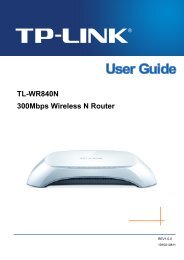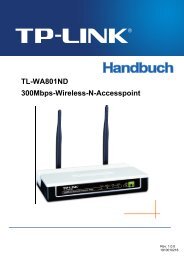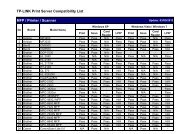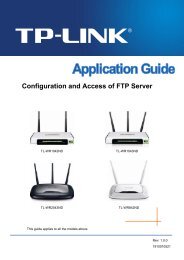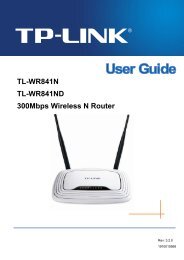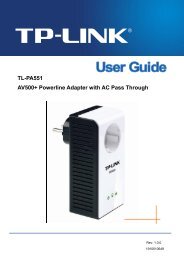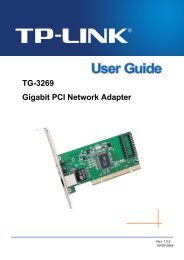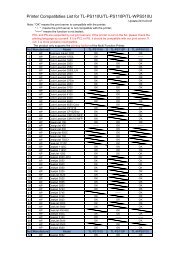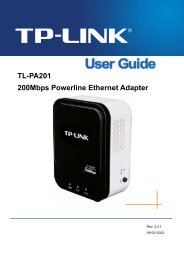TL-SL3428_V3_User_Guide - TP-Link
TL-SL3428_V3_User_Guide - TP-Link
TL-SL3428_V3_User_Guide - TP-Link
You also want an ePaper? Increase the reach of your titles
YUMPU automatically turns print PDFs into web optimized ePapers that Google loves.
Hold Timer: When a GARP entity receives a piece of registration information, it does notsend out a Join message immediately. Instead, to save the bandwidth resources, it starts theHold timer, puts all registration information it receives before the timer times out into one Joinmessage and sends out the message after the timer times out.Join Timer: To transmit the Join messages reliably to other entities, a GARP entity sendseach Join message two times. The Join timer is used to define the interval between the twosending operations of each Join message.Leave Timer: When a GARP entity expects to deregister a piece of attribute information, itsends out a Leave message. Any GARP entity receiving this message starts its Leave timer,and deregisters the attribute information if it does not receives a Join message again beforethe timer times out.LeaveAll Timer: Once a GARP entity starts up, it starts the LeaveAll timer, and sends out aLeaveAll message after the timer times out, so that other GARP entities can re-register all theattribute information on this entity. After that, the entity restarts the LeaveAll timer to begin anew cycle.‣ GVRPGVRP, as an implementation of GARP, maintains dynamic VLAN registration information andpropagates the information to other switches by adopting the same mechanism of GARP.After the GVRP feature is enabled on a switch, the switch receives the VLAN registrationinformation from other switches to dynamically update the local VLAN registration information,including VLAN members, ports through which the VLAN members can be reached, and so on.The switch also propagates the local VLAN registration information to other switches so that all theswitching devices in the same switched network can have the same VLAN information. The VLANregistration information includes not only the static registration information configured locally, butalso the dynamic registration information, which is received from other switches.In this switch, only the port with TRUNK link type can be set as the GVRP application entity tomaintain the VLAN registration information. GVRP has the following three port registration modes:Normal, Fixed, and Forbidden. Normal: In this mode, a port can dynamically register/deregister a VLAN and propagate thedynamic/static VLAN information. Fixed: In this mode, a port cannot register/deregister a VLAN dynamically. It only propagatesstatic VLAN information. That is, the port in Fixed mode only permits the packets of its staticVLAN to pass. Forbidden: In this mode, a port cannot register/deregister VLANs. It only propagates VLAN 1information. That is, the port in Forbidden mode only permits the packets of the default VLAN(namely VLAN 1) to pass.Choose the menu VLAN→GVRP to load the following page.66



